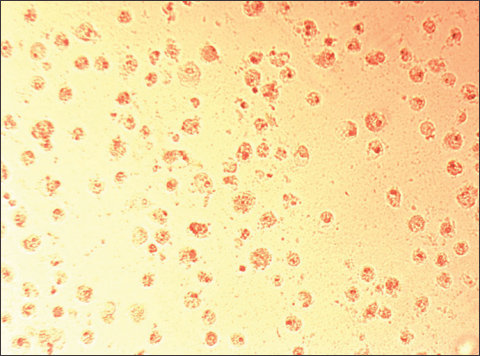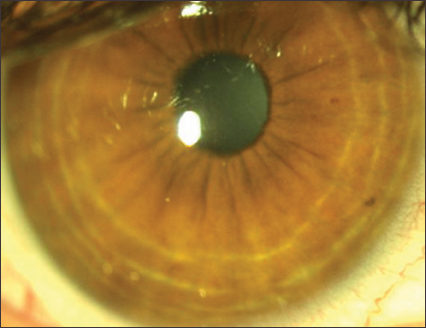Autologous stem cell transplantation may be feasible for advanced keratoconus
A phase 1 pilot study preliminarily showed the safety of autologous adipose-derived adult stem cell transplantation in the corneal stroma and the ability of these cells to survive in vivo and produce new collagen. This form of cellular therapy could potentially help remodel and strengthen the cornea in patients with keratoconus.
“We undertook this study on the basis of our own preclinical investigation. The purpose is to rehabilitate the biology of the cornea using autologous stem cells. In this first pilot study on human corneas, we specifically aimed at proving the feasibility of the surgical technique to implant the stem cells and at assessing the safety of the procedure. We were also able to prove that new collagen is produced via those cells, confirming what we had already proved in animal studies,” Jorge L. Alió, MD, PhD, told Ocular Surgery News.
This prospective series was set up as a cooperation between the Research, Development and Innovation Department of Vissum Instituto Oftalmologico de Alicante, Spain, and the Hospital Universitario La Paz, Madrid, Spain, and three partners in Lebanon: the Laser Vision Center of Beirut, the Reviva Research and Application Center of Middle East Hospital of Beirut and the company Optica General of Saida, coordinated by Mona El Zarif, OD. They sponsored the study and are actively promoting this therapy in the Middle East area.

Cellular therapy of the corneal stroma has gathered interest in the past few years. The research has focused on mesenchymal stem cells from different ocular and non-ocular tissues for their ability to differentiate into keratocytes in vivo. Among them, human adipose tissue has demonstrated to be ideal as a source of autologous stem cells due to easy accessibility, high cell retrieval efficiency and ability of its stem cells to differentiate into multiple cell types.
“ADASCs differentiate into keratocytes and produce new collagen in the stroma,” Alió said. “This was proven in animal models, and our study was the first to show this happening in the human cornea.”
Surgical technique and results
Five patients with advanced keratoconus were included in the study. They underwent liposuction to obtain 250 mL of fat mixed with local anesthetic. The tissue was processed, and transplantable autologous adipose-derived adult stem cells (ADASCs) were obtained by culturing methods.
“In each patient, after administering topical anesthesia, we created a stromal pocket using the IntraLase iFS femtosecond laser (Johnson & Johnson Vision), 9.5 mm in diameter, similar to the pocket we do to implant the Kamra inlay (AcuFocus), at half the depth of the thinnest point measured by Visante AS-OCT (Carl Zeiss Meditec). Through a 30° incision, 3 million cells were transferred with a cannula,” Jorge L. Alió del Barrio, MD, PhD, said. The procedure ended with a contact lens without any sutures.

The procedure, he said, is simple and takes only about 10 minutes. There were concerns about creating a pocket in the thin, weakened, deformed keratoconus corneas, but no complications occurred and no negative effects were observed with regard to corneal function or biomechanics.
“UCVA improved by at least one line and BCVA with rigid contact lenses improved by more than two lines. The refractive sphere improved in two patients and remained stable in the other three patients,” Alió del Barrio said.
No inflammation or rejection occurred, and the corneas were completely transparent 48 hours after the procedure, which shows that the newly produced collagen is clear and that neither the stem cells nor the procedure itself cause opacification.

Source: Mona El Zarif, OD



Future perspectives
“This study suggests that ADASCs can be implanted, that the procedure is safe and that ADASCs produce new, healthy collagen in the diseased eyes. Now we need a longer follow-up to see the therapeutic benefits of this new collagen and its impact on the natural progression of the disease. In the long term, these keratocytes should be able to take over and compensate the defect created by the diseased keratocytes, maybe re-establishing corneal thickness,” Alió said.
The same therapy could potentially treat other forms of corneal dystrophies, in which diseased keratocytes that produce abnormal deposits could be “reprogrammed” or compensated by colonies of newly formed healthy cells, he said.
Another study is currently ongoing to test the feasibility of implanting human corneal collagen impregnated with the stem cells from the adipose tissue of the same patient. This is also an autologous therapy, with no risk of rejection because no foreign tissue is used.
“We increase corneal thickness with collagen but make it biologically active by autologous stem cells. It could be implanted in layers to increase the corneal thickness in advanced cases of keratoconus as a less invasive and safer alternative to transplantation,” Alió said.
This research may open a new area in the treatment of corneal dystrophies.
“For the first time, we have been able to demonstrate that a surgical and biological therapy works. In the future, as we diagnose keratoconus, we might be able to offer an alternative, minimally traumatic and minimally invasive option for even the most advanced stages of the disease,” Alió said. – by Michela Cimberle
- Reference:
- Alió del Barrio JL, et al. Cornea. 2017;doi:10.1097/ICO.0000000000001228.
- For more information:
- Jorge L. Alió, MD, PhD, can be reached at Vissum Corporation, Avenida de Denia, s/n, 03016 Alicante, Spain; email: jlalio@vissum.com.
Disclosure: Alió reports no relevant financial disclosures. Mona El Zarif, OD, Optica General, Lebanon, is the sponsor of this study.
